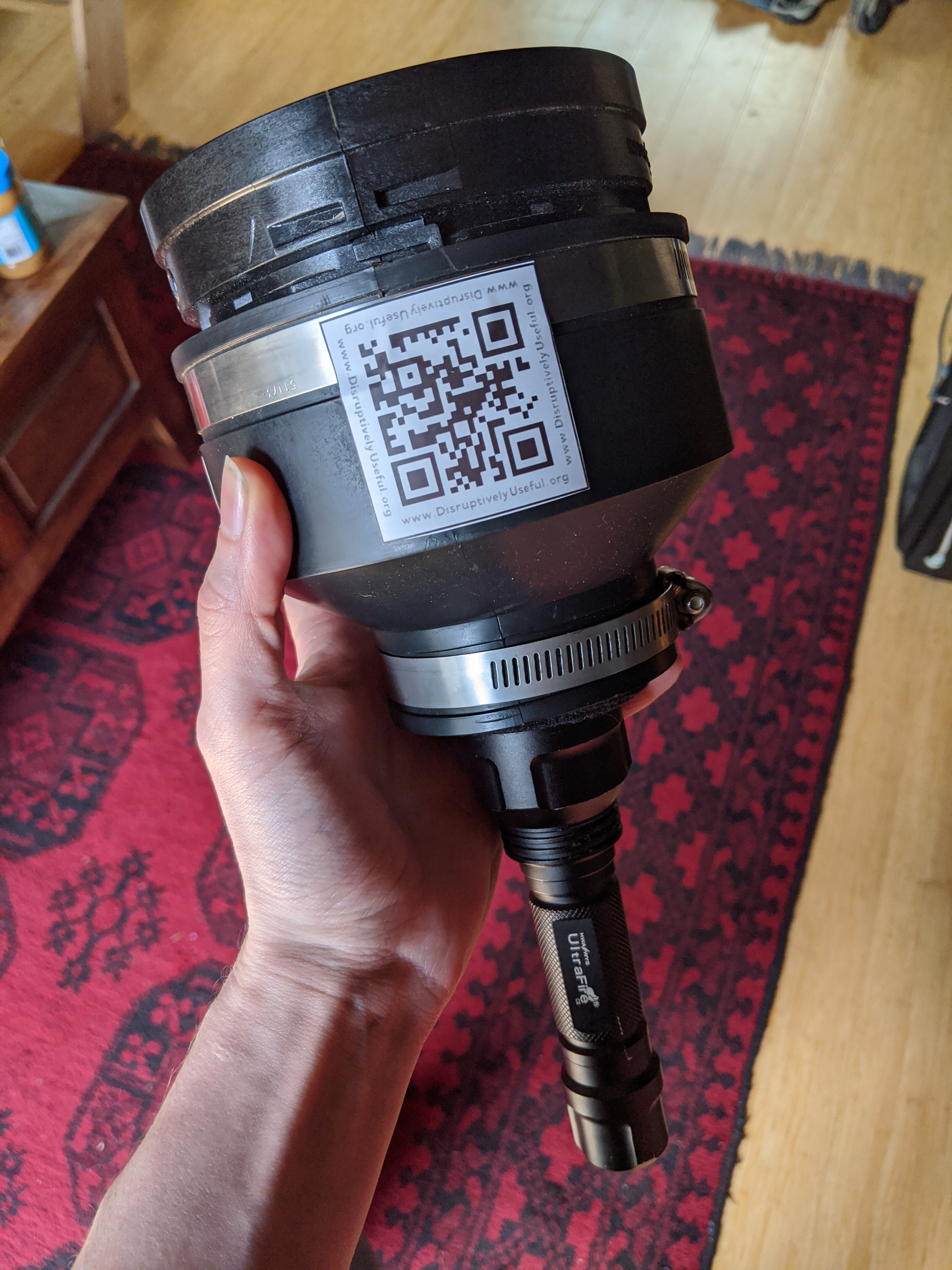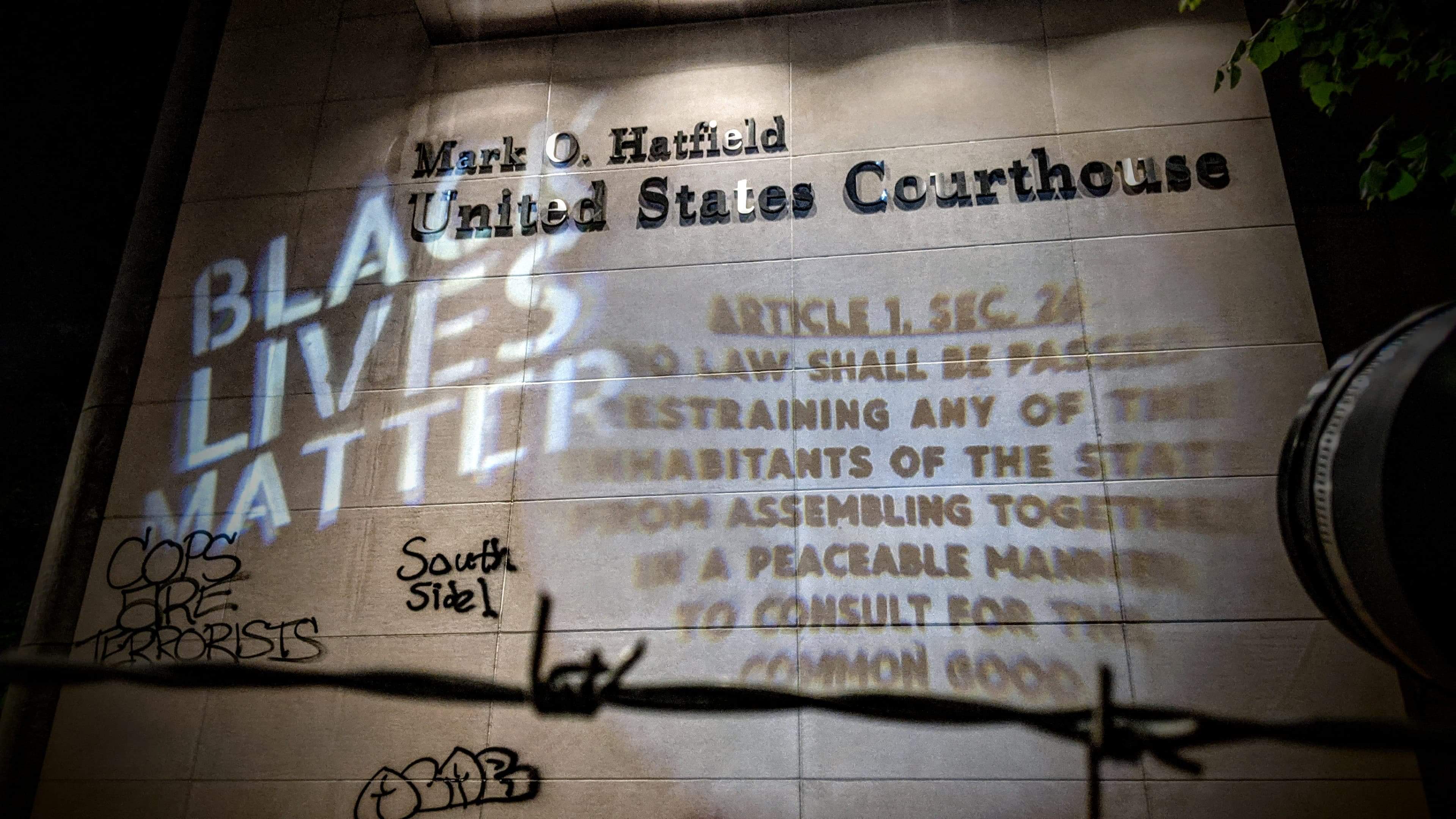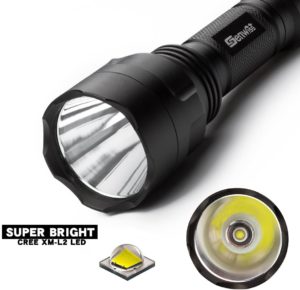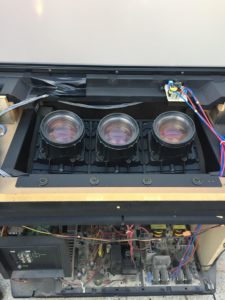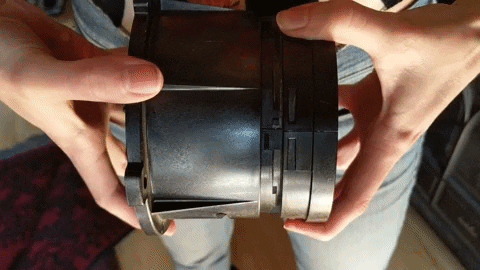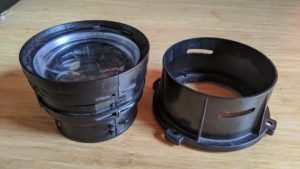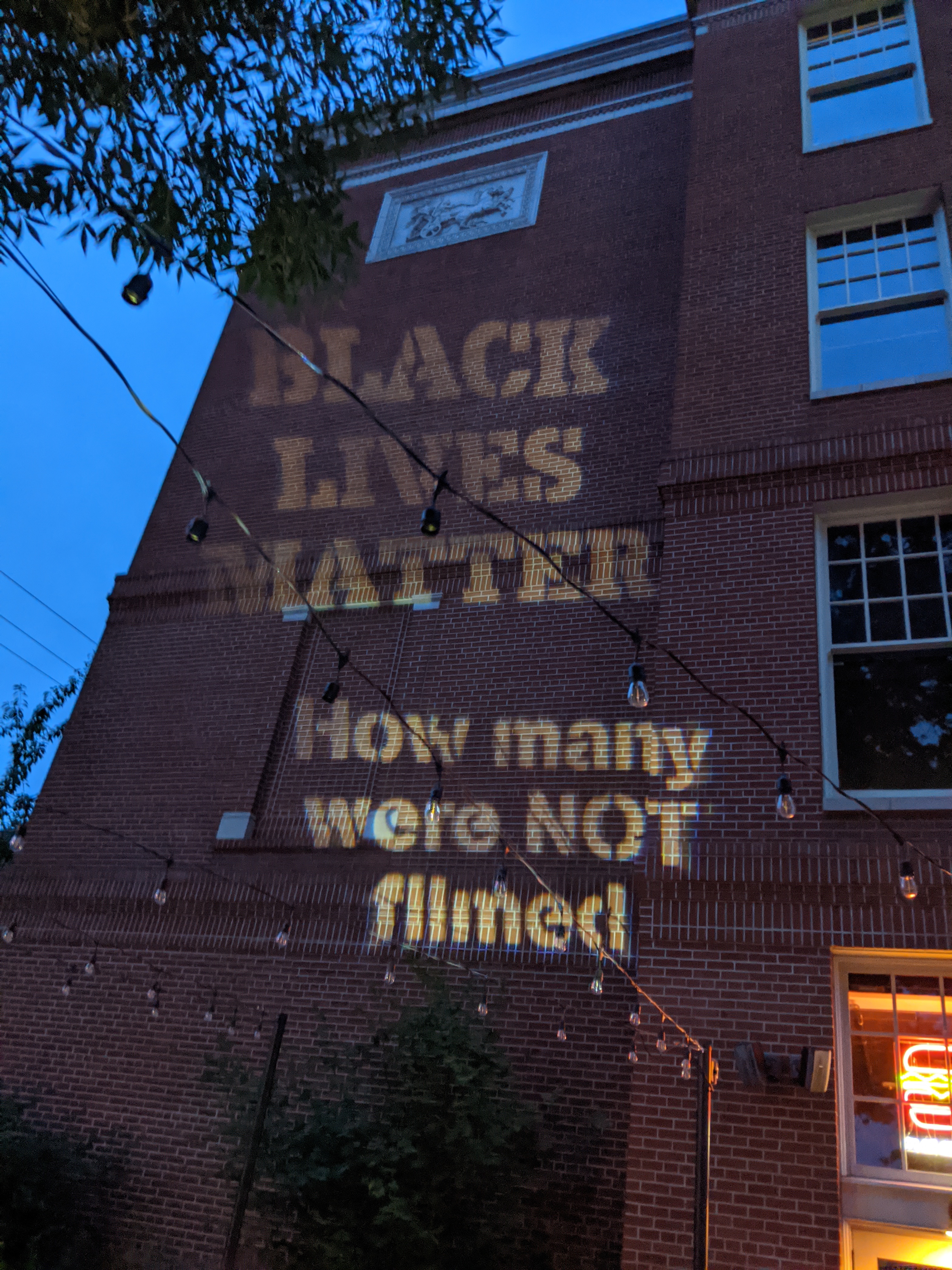Hi! This tutorial is here to help you build a low-profile handheld light projector from relatively accessible hardware store parts. If you scroll down this page a bit you will find TONS of additional detail on how to build this projector, including a parts list, links and even a tutorial video. Most of the information about this project is located on this page (in this README.md file). The other files in this repo are mostly downloadable files to help you lasercut or print stencils for your projector.
If you follow our suggestions of what to buy and use the links we provide here, this project should cost around $45-60 in materials (cheaper or pricier if you find parts on your own).
We use links to Amazon and Ebay in this tutorial, among other places. You are more then welcome to source your parts from elsewhere, and we encourage you to do what feels good.
We have worked hard to give details for the specific build we know works, but hope that people will also try to design similar, not exact copies. This is because A) The exact parts needed for this build may be difficult to source in the future and the links here might break, though similar parts should always be available and B) Alternate builds could quite possibly have advantages of their own, such as lowering cost or improving projection throw.
This project is also completely open source, meaning that you can make, share, use, alter, and yes, even sell this design or any similar design, with no credit or attribution needed. You can (and we encourage you to) fork this repo. This information is yours.
Please watch this tutorial video first.
- a fairly powerful LED flashlight*.
- a lens*
- a stencil*
- a way to couple it all*
*Important details on each of these items are available down this page, in their tutorial sections.
We created a tutorial video with the original parts we found for this build a few years ago to show you how it all fits together.
What you are doing in this project, essentially, is sending a flashlight beam farther and more sharply with a lens then it can do on it’s own. Then you are adding a message with the stencil. The coupling is all about finding the focus, the spacing between the flashlight and lens. This type of projection is called "Gobo" projection, and is often used in theatre and stage settings. “Gobo” stands for “Goes before optics” because putting a stencil between a light and a lens projects a crisp, focused image. A stencil used for projection like this is sometimes referred to as “a gobo”. and can be made of clear acetate sheet, acrylic, wood or metal (depending on how hot your light source gets)
There could be a thousand creative ways to do this type of projection and we try to talk about that in this tutorial. We also give you specifics on what has worked for us in the linked list above, the video, and in the information below.
FLASHLIGHT TIPS:
First, it is important to know that since we created this tutorial several years ago, flashlight technology and parts have evolved at an extremely rapid pace. We try to keep up with linking to flashlights that will work for this build, but it is hard to keep up. This means it is IMPORTANT for you to understand the properties of the type of flashlight that will work for this project, so you can try out ones you can find yourself.
Really any light source can work for this type of projection, but LED flashlights are the cheapest, smallest, safest option as they are very bright, portable, rechargable and don’t produce a lot of heat that could melt or ignite your stencil.
In the build we feature in our tutorial video, we used a 1000 lumin "tactical" flashlight that we got on Amazon a few years ago for around $20. The brighter the better, but a 1000 lumen rated flashlight with a fresh 18650 battery can throw a remarkably large and clear image in reasonable darkness. We have found essentially the same flashlight from a few different suppliers since then, and we suggest you look around yourself.
What to Know to Source Your Own Flashlight
Flashlights that use rechargeable lithium “18650” style batteries are a great option, because 6-8 useable 18650 cells can be recovered from old laptop batteries, and a single 18650 can power one of these flashlights for 4-7 hours. It’s ok if your flashlight uses AA or AAA batteries too, we just like lithium. No matter what, you will probably want extra batteries with you to last the night. Having a 18650 battery charger and extra reachargeable 18650 batteries is a really great investment. These are easily found online.
It doesn’t matter so much which brand of flashlight you use, but we learned the hard way that some LED flashlights use a parabolic reflector to focus the light, and others use a clear plastic dome-like lens. Both work fine for use as a flashlight, but for use as a projector the ones with parabolic reflectors work WAY better, because they hold the stencil much further away from the hot LED and because they don’t complicate the optics.
The ones with (good!) parabolic reflectors look like this:
Notice the shiny, concave internal surface with flat clear plastic cover. This is what you want.
Not this!:
Notice the lack of shiny interior, and the convex, bubble like clear plastic dome cover. Not great for projection.
The head of the flashlight we used fits perfectly into a 1.5” plumbing fitting, designed for ABS pipe, which made coupling it to the lens easy. You should CHECK the diamater of the head of your flashlight, and make sure it will fit into the smaller end of your plumbing coupler. The flashlight we currently suggest is this one, which comes with an extra 18650 battery and battery charger. If your flashlight does not fit into your coupler, try wrapping several layers of fabric, tape or other material around the flashlight until it fits loosely enough to move, but tightly enough to stay in place. We found that long, thin strips of velcro worked very well for this.
FLASHLIGHT RESOURCES:
-
Try different flashlights you already have access to. Check thrift stores! Remember, brighter is better.
-
If you have the funds, you can also just buy a professional gobo projector
STENCIL TIPS:
This style of projection is called “gobo” projection. “Gobo” stands for “Goes before optics” because putting a stencil between a light and a lens projects a crisp, focused image. A stencil used for projection like this is sometimes referred to as “a gobo”. and can be made of clear acetate sheet, acrylic, wood or metal (depending on how hot your light source gets)
You’ll need to be able to make stencils to throw your own images. We used a Glowforge(https://glowforge.com/) basic 40W laser cutter to cut thin (1/16th”) black acrylic for our stencils, which worked well with the style of LED flashlight we suggest. We made a round stencil at 1.61" diameter because that is what fit inside the head of the flashlight we used. We have provided these .svg files in this repo for you to use. They may (probably) need to be resized to fit your flashlight. If you don't have a laser cutter you could ask your local makerspace for access to one, or use an online lasercutting service like Ponoko..
Another, potentially more accessible way of creating stencils is by printing transparencies, which we have also provided files for. Keep in mind, you might need to resize them to fit your flashlight.
If you don’t have access to a laser cutter or printer you can experiement with making your own stencils using different materials, like thin plastic, stiff card stock, or even a tin can and an exacto knife.
Cut-out stencils work best for larger words and simple phrases. For smaller/more text/detailed images, we found that laser engraving an image onto CLEAR or transparent acrylic of any light color, and then spray painting the engraved area black before peeling off the protective paper, worked surprisingly well. It may be worth playing around with that approach if you DO have access to a laser cutter.
Get creative! Maybe let us know what works well for you!
SAFETY TIP: Test your stencil out before-hand and make sure it isn’t getting too hot for the material you are using! This is particularly important if you are using PAPER products to make your stencil.
STENCIL RESOURCES
- We have added .svg files to this repo for lasercutting.
- We have added .pdf files to this repo for printing transparencies.
- If you do not own a lasercutter you can ask your local makerspace to help.
- You can also use a custom online lasercutting service like Ponoko.
- Or, email Claire at clacassidy@gmail.com and we'll mail you a few free stencils.
- Here’s a tutorial on a low-tech DIY metal gobo from a tin can/pie plate.
- You could draw on a sheet of transparent plastic with a sharpie.
- You could cut a stencil out of cardboard with a razor blade, and add tinfoil if it’s getting too hot from the LED flashlight.
- You could 3D print a stencil.
LENS TIPS:
Nearly any lens of any kind will work to some extent, but some will work (much) better than others. All lenses have a focal length- the distance from the lens where the image comes into focus. We used a lens from an old big screen, thicc (CRT) TV, because we had a few lying around. They work well, and 3 of them can be found inside any old boxy projection-style CRT TV. (If you are unsure if a TV is the right kind, try gently poking the screen. Is it large, plastic, textured, and a little floppy in the middle? If so, you’re in luck!)
Side note that the Fresnel lens and first surface mirror in big screen TVs can be used to make solar concentrators and other fun optical projects, but that's for a different tutorial.
If you take off the screen, it should look something like this:
Not everyone wants to rip apart a big screen TV, however, so we did some research and found that you can buy this style of lens on ebay for $5-$20. You want to search for "rear projection television lens", and look for a lens that looks like this:
Each lens comes in two parts: the lens assembly, and a plastic housing that slides along two screws, allowing for fine adjustment of focus. For our purposes, we won’t need the outer housing. Just unscrew the two screw posts and pull the lens away from the housing, like this:
The lens assembly has a stepped shape that makes it easy to find a step with the right diameter to couple to a plumbing fitting. We found that the second step on ours was almost exactly 4″, and fit a 4" FERNCO ABS pipe plumbing fitting*.
*Check out the coupler section below for details on the FERNCO coupler.
In our understanding other optics (lenses) can work well, though we have not played with other lenses much so far. Old 35 mm camera lenses can usually be found at thrift stores for $5-15. They have very high quality optics, and many of the bigger telephoto-style ones will let you make very fine adjustments to the focus and size/throw of your image.
The now-defunct GuerillaBeam project used a 3D printed slide holder to couple 35 mm camera lenses to LED flashlights, which is how we know they work. If you use a camera lens, you’ll have to play around with the spacing between the light, stencil, and lens to find the sweet spot, and then design your coupler accordingly.
SAFETY TIP: To be safe, NEVER LEAVE A BIG SCREEN TV LENS OUT IN THE SUN, it can act as a giant magnifying glass and light things on fire when the sun hits it.
LENS RESOURCES:
- Search for "rear-projection television lens" on Ebay to find a similar lens to the one we used in this tutorial.
- Ask around for old TV lenses and camera lenses.
- Check thrift shops and re-stores.
COUPLER TIPS:
The coupler can be anything that securely holds the flashlight to the lens, and allows you to make small adjustments to the focus. We used a 1.5”x4” rubber FERNCO ABS pipe plumbing fitting, which happened to fit our lens on one end and flashlight on the other, and these should be available at any large hardware store. We prefer the high-quality of a branded FERNCO coupler because they are flexible and durable. Cheaper hard plastic couplers are very hard to work with.
These kinds of fittings come in a wide range of sizes, and are a good, cheap, widely available option for connecting things together. Source your flashlight and lens first, and then find your coupler to match them. The distance between the lens and the stencil is more important than the distance between the light source and the stencil. Find the focal length by simply holding your lens in front of your stencil/flashlight and then source your coupler accordingly.
Since the coupling is all about attaching the flashlight to the lens with the correct distance between them to focus, we think a number of other things could work for this, though we haven't personally tried.
GuerrillaBeam Coupling
The now-defunct GuerillaBeam project is a 3D printed slide holder AKA a coupling meant for a flashlight on one end and a 35mm camera lens on the other end. A number of adaptations have been make and a lot of these 3D printing files can be found when you search "guerillabeam" on Thingiverse.
Crafty Coupling
We are pretty sure you could use materials such as cardboard, tape, hot glue, foam, toilet paper tubes, pool noodles etc to figure out a coupling for your flashlight and lens if you want to get creative with cheap supplies.
COUPLER RESOURCES:
- 1.5 x 4” FERNCO coupler will work for flashlights that are around 1.5 " in diamiter (around the head). If your flashlight diameter is larger you can search for a 2 x 4" FERNCO coupler.
- This part could be crafty, like some stiff cardboard and tape
- Or it could be a 3D printed part custom fitted to your flashlight and lens
Please watch our tutorial video for an overview of how all the parts should fit together.
-
Beautiful Rising on Guerilla Projection as a protest tactic
-
The Illuminator Collective have been light projection activists since 2012 and make tutorials
-
If you have the funds, you can also buy a professional gobo projector
-
You can follow us, the creators, if you would like. Here's Claire's social links and other open source resources, and here's Sam's website.
